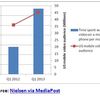By Mae Kowalke, TMCnet Contributor
There was a time when fiber-to the-home was seen as the future of broadband. But all that changed with the introduction of VDSL2 Vectoring.
“With a single innovation, the market shifted,” noted Alcatel-Lucent colleagues Paul Spruyt and Dr. Stefaan Vanhastel in a recent blog post, The Numbers are in: Vectoring 2.0 Makes G.fast Faster. “Copper became a valuable commodity again as operators began using their copper assets to deliver fast broadband speeds faster.”
Making that copper even more valuable potentially is the new G.fast standard.
G.fast can increase aggregate bit rates over copper loops shorter than 250 m to fiber speeds of more than 1 Gb/s, the authors explained. It also delivers a cost advantage over deploying fiber directly to the home.
The trouble is that G.fast suffers from crosstalk even more than VDSL2. Tests by Bell Labs on older, unshielded cables in Austria showed that G.fast reached speeds of 500 Mb/s over 100 m when a single line was active, but they fell to a measly 60 MB/s when crosstalk was introduced as a result of a second G.fast line being added.
Traditional vectoring will not solve the problem. As the authors highlighted, “Through research at Bell Labs, Alcatel-Lucent identified a number of factors that increase the complexity of vectoring with G.fast.”
This prompted Alcatel-Lucent to develop what it calls “vectoring 2.0,” which does enable G.fast to leverage vectoring to reduce the effects of crosstalk. In fact, using vectoring 2.0, Bell Labs was able to reach aggregate speeds of 1.1 Gb/s over a single pair of 70 m lines and 800 Mb/s over a single pair of 100 m lines.
The result is operators now have a number of options to choose from depending on the scenarios.
- For situations where copper must go more than 200 m, VDSL2 vectoring makes the most sense.
- For lengths less than 200 m with multiple subscribers, VDSL2 or VDSL2 vectoring can be used today and G.fast can provide an evolution path if vectoring 2.0 is used.
- For lengths less than 200 m and with only a single subscriber, G.fast will make a lot of sense due to its high bit rates and ease of installation. VDSL2 will be used in these scenarios until G.fast solutions become available.
Source: Alcatel-Lucent
“While G.fast is not yet standardized and won’t be commercially available for several years, it is a natural evolution of VDSL2,” surmised the blog post. “In the meantime, operators can rely on VDSL2 vectoring to serve their customers in a cost-effective way.”













